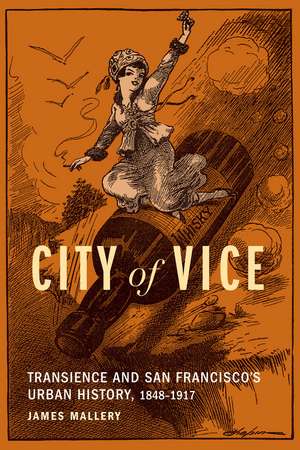City of Vice: Transience and San Francisco's Urban History, 1848–1917
Autor James Malleryen Limba Engleză Hardback – iun 2024
Preț: 431.80 lei
Nou
Puncte Express: 648
Preț estimativ în valută:
82.63€ • 85.78$ • 68.90£
82.63€ • 85.78$ • 68.90£
Carte tipărită la comandă
Livrare economică 22 martie-05 aprilie
Preluare comenzi: 021 569.72.76
Specificații
ISBN-13: 9781496230263
ISBN-10: 1496230264
Pagini: 338
Ilustrații: 12 photographs, 16 illustrations, 9 maps, index
Dimensiuni: 152 x 229 x 15 mm
Greutate: 0.66 kg
Editura: Nebraska
Colecția University of Nebraska Press
Locul publicării:United States
ISBN-10: 1496230264
Pagini: 338
Ilustrații: 12 photographs, 16 illustrations, 9 maps, index
Dimensiuni: 152 x 229 x 15 mm
Greutate: 0.66 kg
Editura: Nebraska
Colecția University of Nebraska Press
Locul publicării:United States
Notă biografică
James Mallery is a licensed architect specializing in existing and historical buildings in Los Angeles. He has a PhD in history and has taught architectural history and U.S. history at various institutions.
Cuprins
List of Illustrations
Acknowledgments
Abbreviations
Introduction
1. Gold Rush and the Walking City, 1850s
2. Waterfront and the New Fulton House, 1893
3. Main Stem and the Industrial Army, 1894
4. Chinatown and Quarantine, 1900
5. Earthquake and Firestorm, 1906
6. Outside Lands and Residence Parks, 1912–13
7. Barbary Coast and the Anti-“vice” Campaigns, 1913
8. Uptown Tenderloin and the Anti-“vice” Campaign, 1917
Conclusion
Notes
Bibliography
Index
Acknowledgments
Abbreviations
Introduction
1. Gold Rush and the Walking City, 1850s
2. Waterfront and the New Fulton House, 1893
3. Main Stem and the Industrial Army, 1894
4. Chinatown and Quarantine, 1900
5. Earthquake and Firestorm, 1906
6. Outside Lands and Residence Parks, 1912–13
7. Barbary Coast and the Anti-“vice” Campaigns, 1913
8. Uptown Tenderloin and the Anti-“vice” Campaign, 1917
Conclusion
Notes
Bibliography
Index
Recenzii
“A fascinating account of San Francisco’s past. Packed with sharp historical insights from rich archival research, the book will appeal to scholars, students, and general readers alike. It will change the way readers view the city’s physical and imaginary landscapes.”—Clare Sears, author of Arresting Dress: Cross-Dressing, Law, and Fascination in Nineteenth-Century San Francisco
“A vibrant history of San Francisco’s multiracial transient living and entertainment districts that unravels urban myths and offers cautionary tales of crusades against vice and crime.”—Nayan Shah, author of Contagious Divides: Epidemics and Race in San Francisco’s Chinatown
“A lively, thoroughly researched, and necessary corrective to the history of cities.”—Jessica Ellen Sewell, author of Women and the Everyday City: Public Space in San Francisco, 1890–1915
“Mallery’s study of San Francisco’s districts of the demimonde and ‘the dangerous classes,’ where tourists and residents enjoyed their illicit pleasures, is a fascinating addition to the historiography of the Pacific Coast metropolis from the gold rush to the Great War.”—William Issel, coauthor of San Francisco, 1865–1932: Politics, Power, and Urban Development
“Urban historians and historians of the Gilded Age and Progressive Era will welcome James Mallery’s deeply researched history of the parts of San Francisco that the city’s dominant white middle- and upper-classes defined as different—different by race, or class, or marital status, or violations of the dominant classes’ morality.”—Robert W. Cherny, coauthor of San Francisco, 1865–1932: Politics, Power, and Urban Development
Descriere
James Mallery explores the implications of such social constructs as gender, race, and class for the development of San Francisco from the gold rush through World War I.
